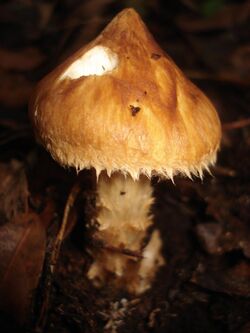Biology:Squamanita
| Squamanita | |
|---|---|

| |
| Squamanita umbonata | |
| Scientific classification | |
| Domain: | Eukaryota |
| Kingdom: | Fungi |
| Division: | Basidiomycota |
| Class: | Agaricomycetes |
| Order: | Agaricales |
| Family: | Squamanitaceae |
| Genus: | Squamanita Imbach (1946)[1] |
| Type species | |
| Squamanita schreieri Imbach (1946)
| |
| Species | |
| |
| Synonyms | |
| |
Squamanita is a genus of parasitic fungi in the family Squamanitaceae. Basidiocarps (fruit bodies) superficially resemble normal agarics (gilled mushrooms) but emerge from parasitized fruit bodies of deformed host agarics.
Taxonomy
The genus was created in 1946 by Swiss mycologist Emil Imbach to accommodate an unusual agaric species, Squamanita schreieri, which L. Schreier had earlier described and illustrated as "Tricholoma X".[1][2] In 1965 Dutch mycologist Cornelis Bas expanded the genus to five species, all of which were characterized by arising from "sclerotial bodies".[3] The possibility that Squamanita might be parasitic on other agarics (the remains of which formed the "sclerotial bodies") was noted by British mycologist Derek Reid in 1983.[4] The discovery of a host fruit body that formed its own pileus together with three Squamanita pilei confirmed the parasitic nature of the genus,[5] a discovery subsequently featured in Nature under the title 'Mycological mystery tour'.[6]
Molecular research, based on cladistic analysis of DNA sequences, has confirmed the parasitism of Squamanita, but has also shown that species belong to two genera: Squamanita sensu stricto and Dissoderma. A number of species previously referred to Squamanita have accordingly been transferred to Dissoderma.[7]
See also
References
- ↑ 1.0 1.1 Imbach EJ (1946). "Pilzflora des Kantons Luzern und der angrenzen Innerschweiz" (in de). Mitteilungen der naturforschenden Gesellschaft Luzern 15: 5–85 (see p. 81).
- ↑ Henrici A (2013). "Squamanita in Britain and Europe". Field Mycology 14 (2): 56–63. doi:10.1016/j.fldmyc.2013.03.008.
- ↑ Bas C. (1965). "The genus Squamanita". Persoonia 3: 331–359.
- ↑ Reid DA (1983). "A second British collection of Squamanita paradoxa". Bull. Br. Mycol. Soc. 17 (2): 111–113. doi:10.1016/S0007-1528(83)80038-8.
- ↑ "Squamanita contortipes, the Rosetta Stone of a mycoparasitic agaric genus". Canadian Journal of Botany 72 (12): 1812–1824. 1994. doi:10.1139/b94-223.
- ↑ Gee H. (1995). "Mycological mystery tour". Nature 375 (6529): 276. doi:10.1038/375276a0. Bibcode: 1995Natur.375..276G.
- ↑ "A phylogenetic overview of Squamanita, with descriptions of nine new species and four new combinations". Mycologia 114 (4): 769–797. 2022. doi:10.1080/00275514.2022.2059639. PMID 35695889. https://figshare.com/articles/dataset/A_phylogenetic_overview_of_i_Squamanita_i_with_descriptions_of_nine_new_species_and_four_new_combinations/20060684.
External links
- Squamanita in Index Fungorum
- The pouch strangler: Squamanita squarrulosa in Spores, moulds, and fungi. A natural history of mushrooms and other fungi in New Zealand.
Wikidata ☰ Q7581935 entry
 |

